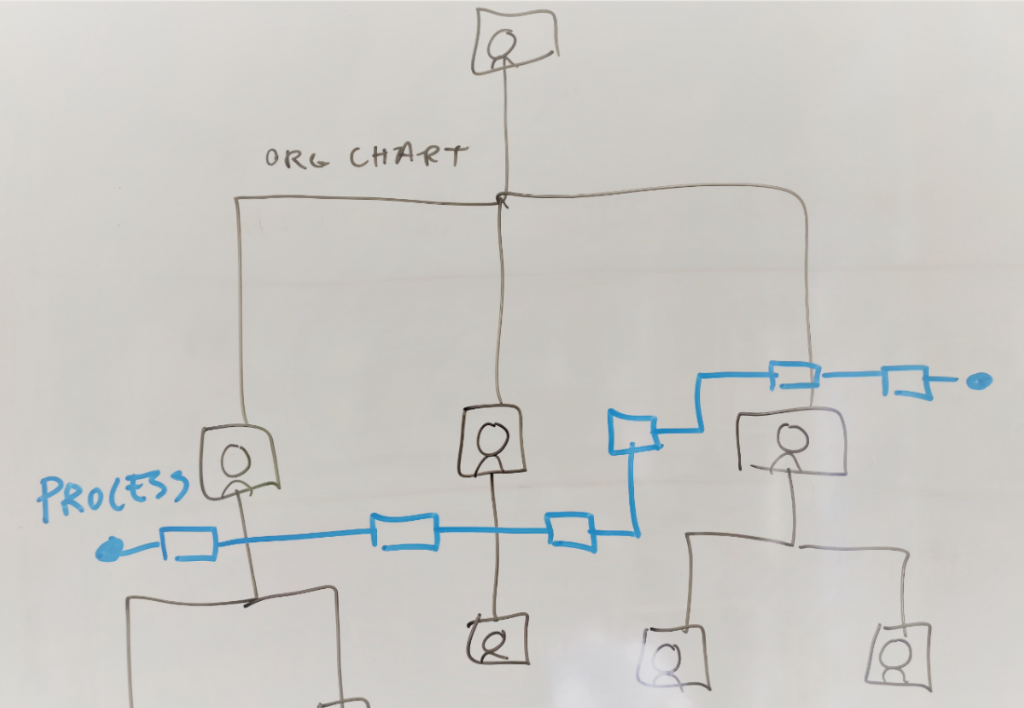
7 reasons process hierarchies go wrong

Endeavouring to create a process hierarchy for your firm is a laudable ambition. It is an illuminating and rewarding business project. It’s a first step in shining a light on how you operate, where waste is happening, and how you can improve. But the trick is getting one right, and all too often they go off course and end up in a dusty tomb.
What is a process hierarchy again?
A process hierarchy visually demonstrates all of the ongoing tasks within your business. Think of one as being a little like an architectural blueprint for a house. Except rather than beams and rafters, a process hierarchy shows the processes that keep your business upright.
They can also be seen as a supplement to your organisational chart. The organisational chart shows how departments and roles are related, while the process hierarchy shows how activities are related and how they deliver the outcomes that are needed to attain your business’s goals:

How do they help?
By recording your processes you give your employees a common language and a clear understanding of their responsibilities. They map the small stuff, like how a receptionist should take a phone call, or how to send a late payment notice, to the very big and important stuff such as hiring a new head of a department. They also allow you to continuously measure and incrementally improve the processes happening across your business, reducing waste and increasing effectivity. Having one really is a no-brainer.
Avoid these 7 reasons process hierarchies go wrong and you’ll be on your way to creating a usable and relevant process hierarchy.
1: It goes no further
If your process hierarchy is not the first step in a longer journey, but the only step, it’s not going to add value or stay current. They have to be seen in the context of a bigger journey towards greater knowledge and improvement. They’re not just a pretty diagram to put on a wall to look at when you’re getting water from the drinking fountain.
2: It’s too high level
Get senior management into a room to map out your value chain, all your processes from start to finish. That’s a start. But it’s not enough to say you have a “marketing and advertising” process owned by the marketing department director. You need to map all of the critical, horizontal processes and the owners of them. Without this, the process hierarchy is too vague, failing to offer the understanding you are seeking. Check out our seven ideas for involving top managers in quality management systems for more.
3: It’s too low level
The next problem is the opposite of the previous; when creating the process hierarchy you get lost in the details and lose sight of the processes that are critical for the business. Especially important at the start of building your process hierarchy, focus on the processes that are directly related to adding value to your business and helping it achieve its core purpose.
4: It’s consultant created
We recognise that creating a process hierarchy is a big undertaking and that it feels natural to want to pay a specialist consultant to handle it for you. But all too often when companies do this, the consultant, being unfamiliar with the company, creates the process hierarchy in his or her own image, using their language rather than the companies. This results in employees struggling to connect with process hierarchy.

Try Gluu for free
Sign up for a 30-day trial.
No credit card required.
5: Using bad names
We’re not talking about yelling expletives at your colleagues here. Though that definitely doesn’t help! We’re talking about when the names chosen for the processes are difficult for employees to relate to in terms of their daily work. The names for the processes should closely reflect the daily work as employees understand it. You can find more information about process naming below.
Tips for your naming convention
We recommend imperative terms, avoiding team names and to be as precise as possible. Going forward, consider process names and outputs to be managed centrally, to avoid duplication and maintain consistency.
6: It’s hard to access
It’s a short and brutal life for any process hierarchy that stays in one room. Or, if it’s controlled on one workstation by one or two people. For them to have meaning within the company, at some point they need to be shared with and collaborated on. This ensures the content of the process hierarchy reflects reality rather than the just the concepts of a small group.
7: The project isn’t managed well
One company we knew of fired the project manager in charge of building the company’s process hierarchy. They then went and put a student in charge of it instead. We won’t say anything more other than the outcome wasn’t ideal. Choose a person with a broad understanding of the company who can just as easily talk with senior management and staff on the shop floor.
Don’t just tick the box
Create a meaningful process hierarchy that reflects reality. This engages employees and shines a light on how you’re doing business is a rewarding business practice. Ultimately, it can improve your bottom line and customer experience. But building one demands sincerity and dedication. There are no shortcuts. Ticking the box by choosing the path of the least resistance will not give you the results you seek. For more on the topic, read our guide to creating a business process hierarchy.
What’s next?
When your process hierarchy is in place then you should start process mapping. For this you should check out our simple process mapping guide.

Try Gluu for free
Sign up for a 30-day trial.
No credit card required.
Frequently Asked Questions
There are a few efficient strategies that can help businesses avoid common pitfalls in process hierarchies. Firstly, streamlining communication is one such strategy. By ensuring that information flows effectively through all levels of the hierarchy, misunderstandings can be kept at bay. Another important strategy is providing proper training to employees so that everyone has a clear understanding of their roles and responsibilities. Additionally, companies could also benefit from implementing more flexible structures that allow for easier adaptability to changes to meet operational requirements. Regular revision and updates of the processes could also facilitate the smooth functioning of the hierarchy.
Let’s consider a software development company as an example. Without a well-defined process hierarchy, employee roles can become confusing and lead to a lack of accountability. For instance, if the quality assurance team isn’t clear about when they should step in to review the product, or if developers are unsure of who to report to, it could lead to delays, poor quality software, and dissatisfied customers. These issues could trigger a domino effect, leading to an overall decline in business performance and possibly damaging the company’s reputation in the market.
Large enterprises and sectors with multi-tier structures like manufacturing, healthcare, and technology are more susceptible to issues with process hierarchies. This is because of their complex operations which demand clear role definitions and streamlined decision-making processes to ensure quality and efficiency.




